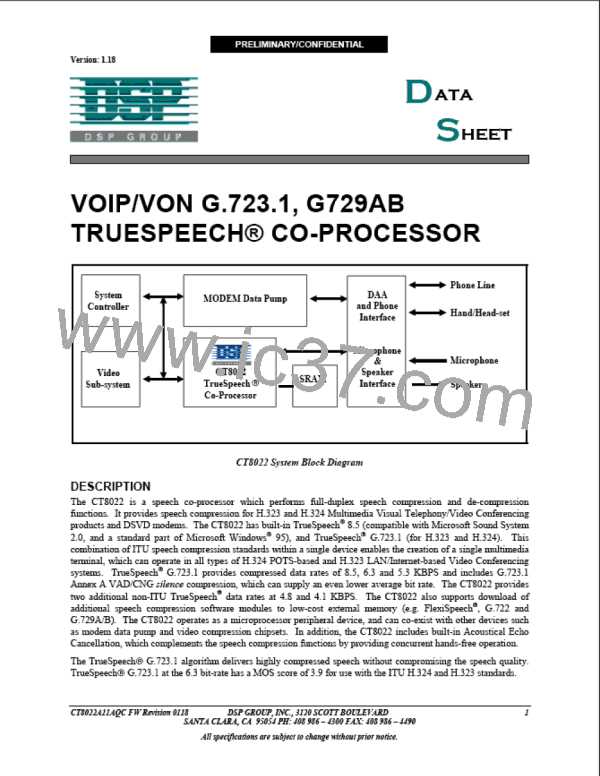TrueSpeech® Co-Processor
PRELIMINARY/CONFIDENTIAL
Version: 1.18
9.8.6
Inserting Silence During Compressed Speech Playback
When the CT8022 performs playback in any of the TrueSpeech modes (8.5, 6.3, 5.3, 4.8 or 4.1) it interprets a speech
frame that contains all zeros as an instruction to output 30ms (one frame period) of pure silence.
9.8.7
Activating The G.723.1 Frame Erasure Mechanism
When the CT8022 performs playback of G.723.1/TrueSpeech 6.3, 5.3, 4.8 or 4.1 speech frames, it interprets a
speech frame that has the first two words set to FFFFH. The remainder of the speech frame is set to all zeros as an
instruction to perform Frame Erasure. When Frame Erasure is activated, the CT8022 attempts to construct a
replacement for a missing speech frame by extrapolation from previous valid speech frames. The Host software and
system communication protocol are responsible for sending of a Frame Erasure frame to the CT8022 based upon
detection of dropped or corrupted speech frames. The G.723.1 speech frames themselves do not include any built-in
error detection mechanism.
9.8.8
G.723.1 Comfort Noise Generation (CNG)
In accordance with Annex A of the ITU G.723.1 specification, the CT8022 will automatically decode CNG frames
generated by the Voice Activity Detector (VAD) of a G.723.1 encoder. Decoding of CNG frames is based on
examination of the two least significant bits of the first data word of each G.723.1 speech frame. The purpose of the
VAD/CNG frame in the G.723.1 Annex A specification is to provide approximate reconstruction of the background
noise level and energy spectrum during periods of silence that occur between periods of active speech.
The two least significant bits of the first word of the TrueSpeech 6.3 and 5.3 frames are defined by the ITU-T
G.723.1 v5.1 (final formal release) specification to indicate the speech data rate as shown:
Bit 1-0
Frame
Type
Data Rate
Number of Significant
Data Words
00
01
10
0
1
2
TrueSpeech 6.3 data frame (12 words)
TrueSpeech 5.3 data frame (10 words)
Silence/Comfort Noise Generation frame (only first 2 words
contain useful data) All other data words are set to zero
12
10
2
11
3
Repeat last CNG frame (only least significant 2 bits of first data
word are used) All other data words are set to zero
2 bits
Compatibility Note:
The Bit 1-0 encoding of the CT8022 is different from that used in older firmware versions of the
CT8020 that implemented pre-release versions of G.723.1, (firmware revisions 0109 and 0112 part
numbers CT8020A11AQC and CT8020A11BQC). The full production release, CT8020D11AQC
(firmware revision 0114) implements the final v5.1 G.723.1 release, as do all versions of the CT8022.
When sending a type 3 frame to the CT8022 playback channel (two least significant bits = 11), it is necessary to
distinguish this type of frame from the Frame Erasure frame (FFFF FFFFH). All the unused bits in the type 3 frame
should be set to zero. Although the CNG frames require fewer bits for actual transmission, the Host must pad the
CNG frames with zeros when writing the frame to the CT8022 so that the CNG frame size matches the size of the
normal speech frame. The CNG frame should be in the form 0000 0003H to avoid confusion with the special FFFF
FFFFH Frame Erasure frame.
When reading or writing speech frames to or from the CT8022, the number of physical words transferred for each
individual frame is fixed during each record/playback session. For example, if the record/playback session starts in
6.3 mode, then all frames will contain 12 words. Frames that use less than this number of words for actual data will
have the unused portion of the frame set to zero. This approach simplifies the coding of low-level driver software
such that it does not need to deal with variable-sized data frames. This is particularly significant when dealing with
DMA-type transfer.
82
DSP GROUP, INC., 3120 SCOTT BOULEVARD CT8022A11AQC FW Revision 0118
SANTA CLARA, CA 95054 PH: 408 986 – 4300 FAX: 408 986 – 4490
All specifications are subject to change without prior notice.

 ETC [ ETC ]
ETC [ ETC ]